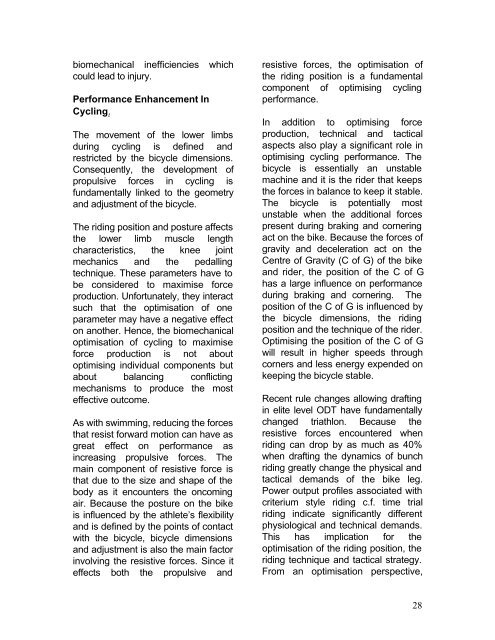MAXIMISING OLYMPIC DISTANCE TRIATHLON PERFORMANCE ...
MAXIMISING OLYMPIC DISTANCE TRIATHLON PERFORMANCE ...
MAXIMISING OLYMPIC DISTANCE TRIATHLON PERFORMANCE ...
You also want an ePaper? Increase the reach of your titles
YUMPU automatically turns print PDFs into web optimized ePapers that Google loves.
iomechanical inefficiencies whichcould lead to injury.Performance Enhancement InCycling.The movement of the lower limbsduring cycling is defined andrestricted by the bicycle dimensions.Consequently, the development ofpropulsive forces in cycling isfundamentally linked to the geometryand adjustment of the bicycle.The riding position and posture affectsthe lower limb muscle lengthcharacteristics, the knee jointmechanics and the pedallingtechnique. These parameters have tobe considered to maximise forceproduction. Unfortunately, they interactsuch that the optimisation of oneparameter may have a negative effecton another. Hence, the biomechanicaloptimisation of cycling to maximiseforce production is not aboutoptimising individual components butabout balancing conflictingmechanisms to produce the mosteffective outcome.As with swimming, reducing the forcesthat resist forward motion can have asgreat effect on performance asincreasing propulsive forces. Themain component of resistive force isthat due to the size and shape of thebody as it encounters the oncomingair. Because the posture on the bikeis influenced by the athlete’s flexibilityand is defined by the points of contactwith the bicycle, bicycle dimensionsand adjustment is also the main factorinvolving the resistive forces. Since iteffects both the propulsive andresistive forces, the optimisation ofthe riding position is a fundamentalcomponent of optimising cyclingperformance.In addition to optimising forceproduction, technical and tacticalaspects also play a significant role inoptimising cycling performance. Thebicycle is essentially an unstablemachine and it is the rider that keepsthe forces in balance to keep it stable.The bicycle is potentially mostunstable when the additional forcespresent during braking and corneringact on the bike. Because the forces ofgravity and deceleration act on theCentre of Gravity (C of G) of the bikeand rider, the position of the C of Ghas a large influence on performanceduring braking and cornering. Theposition of the C of G is influenced bythe bicycle dimensions, the ridingposition and the technique of the rider.Optimising the position of the C of Gwill result in higher speeds throughcorners and less energy expended onkeeping the bicycle stable.Recent rule changes allowing draftingin elite level ODT have fundamentallychanged triathlon. Because theresistive forces encountered whenriding can drop by as much as 40%when drafting the dynamics of bunchriding greatly change the physical andtactical demands of the bike leg.Power output profiles associated withcriterium style riding c.f. time trialriding indicate significantly differentphysiological and technical demands.This has implication for theoptimisation of the riding position, theriding technique and tactical strategy.From an optimisation perspective,28


